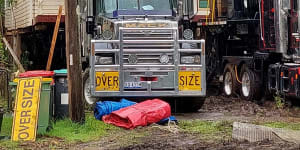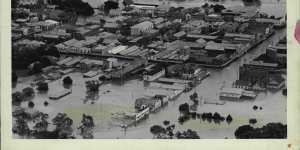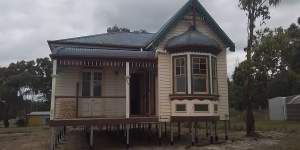“I jumped out of bed,ran out onto the street,and there was my house,” she recalled. “It was horrible,but I knew it would look really awful. To see your house chopped up in pieces is not nice.”

Tess Dellagiacoma’s cottage is prepared for its journey.Matty John
House-moving specialists had removed the roof of the heritage-listed Federation cottage and sawn it in two for its four-hour journey under police escort across the Great Dividing Range,from its original home at 312 Molesworth Street,Lismore,to its new resting place in a small country town just over the Queensland border.
It was the first house to leave Lismore in the aftermath of the record-breaking flood that devastated the city two years ago,rendering many homes unlivable and prompting a government buyback of the worst-affected land. About 30 more of the city’s old houses could follow suit.
Photographs of the cottage leaving its resting place of 120 years drew hundreds of comments on social media from locals who were relieved to see it saved from future floods but sad to see it leave the city where it had served as shelter and home for generations of working-class families.
Local house relocation advocate Harper Dalton,who once lived in the cottage,said Lismore’s old timber houses helped weave the city together,and he hoped they could be kept in the local area. But he said the lack of available flood-free land made that difficult.

“Ideally we would have a heritage suburb with a dedicated flood-free area where the heritage homes would go,” he said. “I’d love to see more and more of these beautiful homes saved and relocated but stay within the LGA they have come from,to retain the social fabric and community identity.”
A new land release of 400 blocks in Lismore,expected to be made available in 2026,will be initially opened to flood victims who have received a land buyback as part of a $700 million government scheme. About 5000 homes were flooded in Lismore and about 700 people across the Northern Rivers have received a buyback offer.
Archives and property records for Dellagiacoma’s cottage show that,as the 20th century ticked by,young brides set out from its doorstep to make their own lives,bereft widows returned to its sanctuary after burying their husbands,and the cottage went from housing tenants to housing owners as Australia became a nation of landowners after World War II.

Arthur Cyril McKie as a soldier in 1916,during World War I.State Library of NSW archives
Its first occupants were sawmill employees,painters,grocers and postal workers who paid rent to George Exton,a member of one of Lismore’s pioneer families. Exton bought the land in 1903 for 100 pounds and owned four neighbouring tenanted houses on Molesworth Street while living across the road for more than 50 years. The street,two blocks from the river,was originally a field from which city planners carved out Lismore.
One of Exton’s tenants in the cottage was Arthur Cyril McKie,a World War I veteran who was only 17 years old when he left his apprenticeship to a Lismore coach trimmer to become a soldier.
McKie was in the trenches on the Western Front in 1917 when he was taken prisoner while laying wire in no man’s land. Freed at the end of the war,he returned to Lismore to resume his apprenticeship,where he married Sylvia Munn.
By 1942 the couple were living at Exton’s cottage with their youngest child,15-year-old Jean,while McKie ran a motor business in town. McKie died in hospital that July,aged 44,after months of ill health,and death notices suggest Sylvia was heartbroken. By 1949 she and Jean were no longer living at the house.
Exton finally sold it in 1954,to Bentley farmer Henry Wood,but its new owner barely had the keys in his hand when the Wilsons River flooded to a record level that February and inundated the house – probably not for the first time – just 19 days after Wood took ownership.

The Lismore CBD a day after the 1954 flood.The Telegraph Feature Service Brisbane
“It came onto the front verandah and we had to stand on a stool to get out of the water,” Wood’s daughter Margaret,who was aged 13 at the time,told theHeraldlast week,70 years to the day after the 1954 flood,which set a record that stood until 2022.
“It was bloody scary … I don’t think we got rescued. I think the water just eventually went down … I couldn’t swim.”
Henry Wood died a month after the flood,aged 68,after a short illness. The house stayed in the family until 1973,and Margaret’s niece,Kaye Durham,remembers being “deathly scared” of the river while she was living there with her three young children,while expecting her fourth.
One of the cottage’s subsequent owners lifted the house onto stilts,above the 1954 flood level,but even that was not enough to stop the water in 2022,which was two metres higher again.

The house on its new block of land.
Dellagiacoma,who bought the house in 2015,qualified for a buyback and was allowed to take the house with her as part of the property settlement,although it took months of bureaucratic wrangling to make that happen.
She intends to return the cottage to the rental market and remain living next door. She hopes the old cottage will continue to provide shelter for people from its new resting place,away from flood this time,although perhaps not from bushfire.
“I just always felt really lucky to be in such beautiful surroundings,and also I used to think of all the happy families who had been through that house,” Dellagiacoma said of her time living at No.312.
“I feel really committed to it because it’s got historic value. It’s just so beautiful … Every time I see it I’m so happy.”
Start the day with a summary of the day’s most important and interesting stories,analysis and insights..